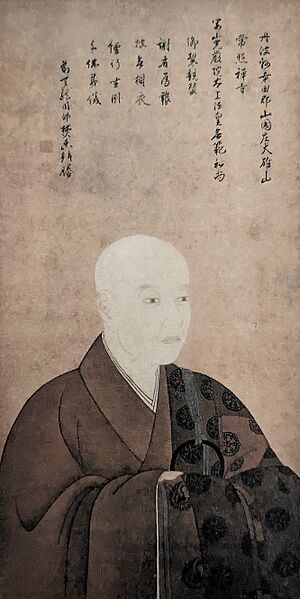Emperor Kōgon facts for kids
Quick facts for kids Emperor Kōgon光厳天皇 |
|||||
|---|---|---|---|---|---|
 |
|||||
| 1st Northern Emperor | |||||
| Reign | October 22, 1331 – July 7, 1333 | ||||
| Predecessor | Go-Daigo | ||||
| Successor | Kōmyō | ||||
| Born | August 1, 1313 | ||||
| Died | August 5, 1364 (aged 51) | ||||
| Spouse | Princess Yoshiko Princess Hisako |
||||
| Issue Among others... |
Emperor Sukō Emperor Go-Kōgon |
||||
|
|||||
| Father | Emperor Go-Fushimi | ||||
| Mother | Saionji (Fujiwara) Neishi | ||||
| Signature |  |
||||
Emperor Kōgon (光厳天皇, Kōgon-tennō, August 1, 1313 – August 5, 1364) was an important figure in Japanese history. He was the first emperor of the Northern Court during a time called the Period of the Northern and Southern Courts. This was a period when Japan had two different imperial courts, each claiming to be the true one. Kōgon ruled from 1331 to 1333.
Contents
Who Was Emperor Kōgon?
Before he became emperor, his personal name was Kazuhito. He was the third son of Emperor Go-Fushimi. His mother was Kōgimon'in Neishi. He was also adopted by his uncle, Emperor Hanazono.
Kōgon had several children. Two of his sons later became emperors of the Northern Court:
- Imperial Prince Okihito, who became Emperor Sukō
- Imperial Prince Iyahito, who became Emperor Go-Kōgon
Becoming Emperor
Kōgon believed he was the rightful emperor from October 22, 1331, to July 7, 1333. In 1326, he was named the Crown Prince and heir to Emperor Go-Daigo. At that time, the Kamakura shogunate (Japan's military government) had decided that the throne would switch between two different imperial families every ten years. These families were the Daikakuji line and the Jimyōin line. However, Emperor Go-Daigo did not follow this agreement.
In 1331, Emperor Go-Daigo tried to overthrow the shogunate for a second time. The shogunate caught him and sent him away to the Oki Islands. Then, they made Kōgon the new emperor on October 22.
The Kenmu Restoration
In 1333, Emperor Go-Daigo escaped from Oki. He gathered an army with the help of Nawa Nagatoshi. Meanwhile, Ashikaga Takauji, a powerful general, turned against the shogunate and supported Emperor Go-Daigo. Takauji attacked the shogunate's leaders in Kyoto. They tried to escape but were captured.
On July 7, 1333, Go-Daigo took the throne back from Emperor Kōgon. He tried to bring back full imperial rule in an event called the Kenmu Restoration. However, this attempt did not last long because Ashikaga Takauji eventually turned against Go-Daigo too.
The Northern and Southern Courts
In 1336, Takauji made Kōgon's younger brother, Emperor Kōmyō, the new emperor. Emperor Go-Daigo fled to Yoshino and continued to claim he was the true emperor. This led to the creation of two separate imperial courts:
- The Southern Court, led by Go-Daigo, was in Yoshino.
- The Northern Court, led by Kōmyō (and later Kōgon's sons), stayed in Kyoto.
This period, known as the Northern and Southern Courts Period, lasted until 1392.
Later Life and Death
In April 1352, during a conflict within the Ashikaga clan, Emperor Go-Murakami of the Southern Court captured Kyoto. He took Emperor Kōgon, Emperor Kōmyō, Emperor Sukō, and the Crown Prince Tadahito. They were taken to Anau, where the Southern Court was located.
After this, Kōgon was kept under house arrest for the rest of his life. In his final years, he became a Zen Buddhist. He passed away on August 5, 1364.
Eras During Kōgon's Time
The years of Kōgon's reign are known by different era names or nengō. These eras help historians keep track of time in Japanese history.

